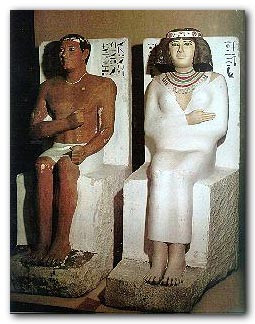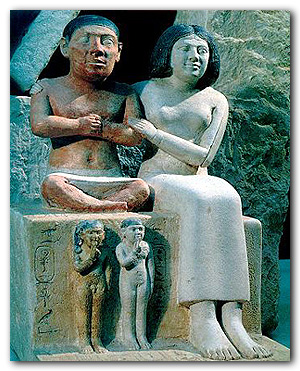Marriage
in Ancient Egypt.
| |
Egyptology Articles
Herbs and Aroma
Alternative
Medicine
Aroma Therapy
|
|
The
ancient Egyptians held marriage as a sacred bond. The family was broken
down into roles that each would play in order for things to run
smoothly. The father was the one who would work all day. In smaller
households the mother was in charge of all things pertaining to the
house. Cooking, cleaning and watching the children were all her
responsibilities. Egyptians seem to have taken mates in what most often
appears to be lifelong monogamous relationships. marriage and a close
family played an integral role in ancient Egypt.
A bride would be young, about 14 or 15 years old. Her husband could be
anywhere from 17 to 20—or older if he was divorced or a widower. The
ancient Egyptians were encouraged to marry young, considering that the
life span at this time was relatively short.
Many
marriages were arranged with parental consent needed, as they have been in all
societies, especially among the upper classes. But the abundance of love poetry
between young people signifies that many couples did fall in love and choose
each other as mates. Women played a large role in arranging a marriage. A suitor
sometimes used a female go-between to approach the girl’s mother—not her
father.
Interestingly, one of the most affectionate titles
you could call your love was "brother" or "sister" in
ancient Egypt. This had nothing to do with sibling relations, but led many
archaeologists and scholars to wrongly assume that most ancient Egyptians
married their siblings. Actually, this usually occurred only among royalty—and
was not a common occurrence.
|
 |
The
Wedding Day:
The
day of the marriage was really quite simple. The bride merely moved her
belongings into the home of her husband. He might be living alone or with his
parents.
So
what did the bride wear? She probably wore a long dress or tunic made of linen,
which may have been covered from head to toe with bead-net. If she owned any
gold, silver or lapis, she probably adorned herself with those, too.
Even
though there was no official ceremony, knowing how much the ancient Egyptians
loved music, dance and food, there were bound to be family celebrations in honor
of the uniting couple.
Museums
are filled with statues and paintings showing husbands and wives with their arms
around each other’s waists, holding hands or offering each other flowers or
food. Love and affection was indeed a part of the Egyptian marriage, and our
Egyptian bride could expect to be loved and respected by her husband.
Entering
into a marriage was described as 'making a wife' or 'taking a wife', but it
seems that the girl's father had the main say. If the girl had no father, an
uncle would step in. In the absence of any preexisting agreement it seems that
the girl's consent to a marriage was unimportant until the 26th dynasty, when
brides also began to have a say.
The
Marriage Contract
Most
marriages had a contract drawn up between the parties. The poorer classes
probably did not do this because they probably had few possessions to consider
and also the cost of a scribe would have been
 costly. Marriage settlements were drawn up between
a woman’s father and her prospective husband, although many times the woman
herself was part of the contract. The sole purpose of the contract was to
establish the rights of both parties to maintenance and possessions during the
marriage and after divorce if it should occur.
costly. Marriage settlements were drawn up between
a woman’s father and her prospective husband, although many times the woman
herself was part of the contract. The sole purpose of the contract was to
establish the rights of both parties to maintenance and possessions during the
marriage and after divorce if it should occur.
A
standard marriage contract that had been found among the numerous records left
by the ancient Egyptians. It contained:
-
The date (the year of the
reign of the ruling monarch)
-
The contractors (future
husband and wife)
-
The names of both sets of
parents
-
Husband’s profession
(wife’s rarely mentioned)
-
The scribe who drew up
the contract
-
The names of the
witnesses
The
finished document was given to a third party for safekeeping or kept among the
records of the local temple.
A
man could marry as soon as he was physically mature and had reached a point in
his chosen career that ensured his ability to provide for his wife and for the
children they could expect.
Most
Egyptians were content to have only one wife. Marriage was an expensive matter
for the man, and the whole contract system provided such far-reaching safeguards
for the material rights of wives and children that most men could only afford
one wife at a time.
Marriages were most
often between people of the same social class, but there seems to have been
little regard given to race or even nationality. It was not unusual for a
northern Egyptian to marry a Nubian, or someone even from another country.
Marriage
contracts do not generally tell the age of the parties, but we know from other
documents that marriage almost always occurred after sexual adulthood. The
average age for girls to enter puberty was 12 to 13, and around 14 for boys.
Indeed boys, who had to achieve some work abilities in order to support a wife
and future children, were usually 15 or over before contemplating marriage.
If the marriage ended in divorce, the rights of the wife were equally protected.
Generally, she was entitled to support from her husband, especially if she was
rejected by him through no fault of her own. The amount might equal one third of
the settlement or even more. If the bride ended up committing adultery (which
was extremely frowned upon for both men and women), she still had certain rights
to maintenance from her former husband. Monogamy, except for some of the higher
classes and royalty, seemed to be the rule for most ancient Egyptian couples.
Particularly during the
early periods of ancient Egypt, the future husband made a payment to the bride's
father, usually amounting to about the cost of a slave. Later, this
practice was abandoned and later the practice was reversed where often the
father of the bride had to compensate the future husband for her upkeep.
However, if divorce occurred, the husband was obligated to continue some support
to his ex-wife, usually amounting to about one third of his earnings.
Marriages
between kin were familiar among the common folk. Step-brothers and sisters
married, as did uncles and nieces quite frequently, and cousins still more so.
Between very close blood-relations,
however, it was wholly exceptional among ordinary people.
The tradition of brother/sister or father/daughter marriages
was mostly confined to the royalty of Egypt In tales from Egyptian mythology,
gods marriage between brothers and sisters and fathers and daughters were common
from the earliest periods, and so Egyptian kings may have felt that it was a
royal thing to do. However, there are also theories that brother/sister
marriages may also have strengthened the king's claim to rule.
Divorce
was as easily initiated as marriage. Divorce could be brought about by either
party; it was a private matter and the government took no interest in it.
The
most common reasons for a husband to divorce his wife included the inability to
bear children, especially a son; the desire to marry someone else or that she
simply stopped pleasing him. A woman could divorce her husband for mental or
physical cruelty or adultery. In some cases, if the woman chose to divorce, she
forfeited her right to communal property.
Once
divorced, both men and women could remarry as soon as they wished. And from the
archives we have found, it seems that they readily did. It’s also apparent
that our ancient bride, with the ease of marriage and divorce and the financial
protection she generally received, had a better time of it than some brides in
modern times.
All of this said, there
are many indications that husbands and wives in ancient Egypt were often happy
and in love. There are many touching portraits and statues of families
including spouses and their children that reveal marital delight and warmth
within the family.
|
You may freely reprint this article
or place it on your website by
adding this statement: Courtesy of www.kingtutshop.com
|

